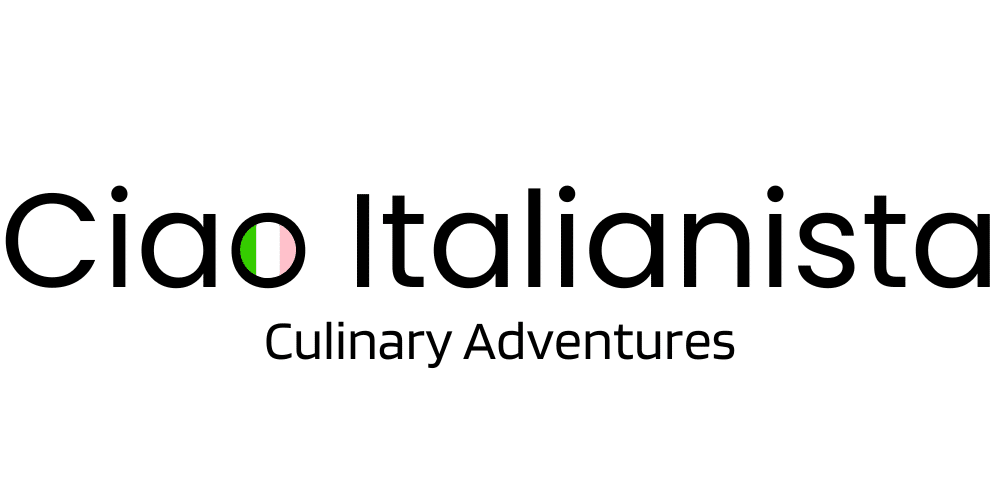Ciao Italianista contains affiliate links and is a member of the Amazon Services LLS Associates Program. If you make a purchase using one of these Amazon links, I may receive compensation at no extra charge to you. See my disclosure policy for more information.
Twilight Trastevere Food Tour Review: My Best Eating Experience in Rome
Are you looking for Twilight Trastevere food tour reviews? Keep reading!
If you want the best food tour in Rome, then the Twilight Trastevere Food Tour by Eating Europe is for you!
I spent over four hours eating, laughing, and creating memories during this immersive culinary experience and I can confidently say it was my favorite thing to do in Rome.
This funky, bohemian neighborhood of Rome boasts authentic trattorias, salumerias with craft beer, traditional Roman cuisine, and family bakeries.
Whether you’re a solo traveler, traveling with friends, a couple, or a family, the Twilight Trastevere food tour appeals to everyone. From the melone e prosciutto appetizer to the bucatini all’amatriciana pasta dish, you’re sure to fill your stomach with mouthwatering treats on this tour.
So grab your appetite and get ready to explore the stops along the Twilight Trastevere food tour.
Twilight Trastevere Food Tour Review: My Best Eating Experience in Rome
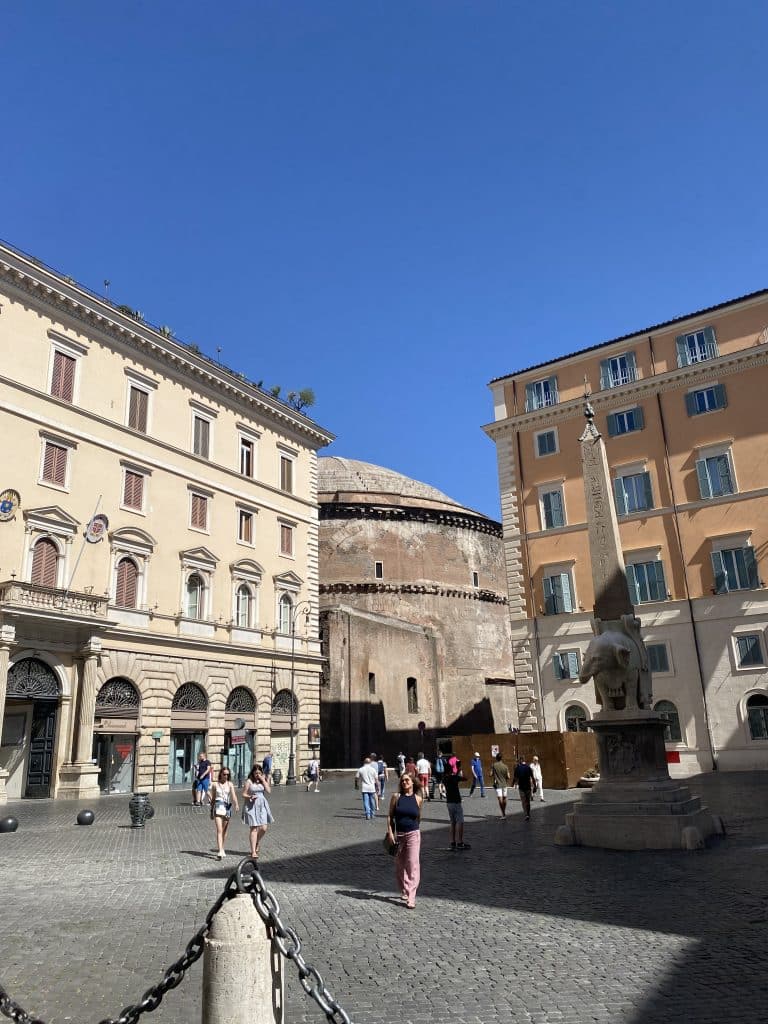
Meeting Point for Twilight Trastevere Food Tour
The meeting point for this tour is in the Piazza di San Bartolomeo all’isola. Using Google Maps, we walked here from our hotel near the Pantheon over the Ponte Fabricio bridge (oldest Roman bridge built in 62 BC) onto this island in the middle of the Tiber River.
Our tour guide, Gian Luca, was waiting for us by the gelato restaurant. He told us to go into the Basilica of San Bartolomeo while we waited. The cool dark air smelling of incense and sounding of monks chanting inside this 1,000 year old cathedral was such a relief from the heat.
When everyone had arrived, we followed our guide off the other side of the island on a bridge over the river into Trastevere.
Meaning of Trastevere
Trastevere literally means beyond the Tiber in Latin. It’s an offbeat, artistic neighborhood filled with musicians and fire dancers at night.
This is where Jewish, Syrian and other immigrants from the Eastern Empire once settled and made their homes. Although later in 1555, Pope Paul IV forced the Jews across the river into the Jewish Ghetto. It’s still a working class neighborhood today.
The area has also attracted many artists and musicians so you can find interesting artisan shops nestled in the winding streets.
Walking through the maze of narrow alleys, you can find tons of pubs and restaurants. There are many categories of eateries in Italy and you sample them all on this tour.
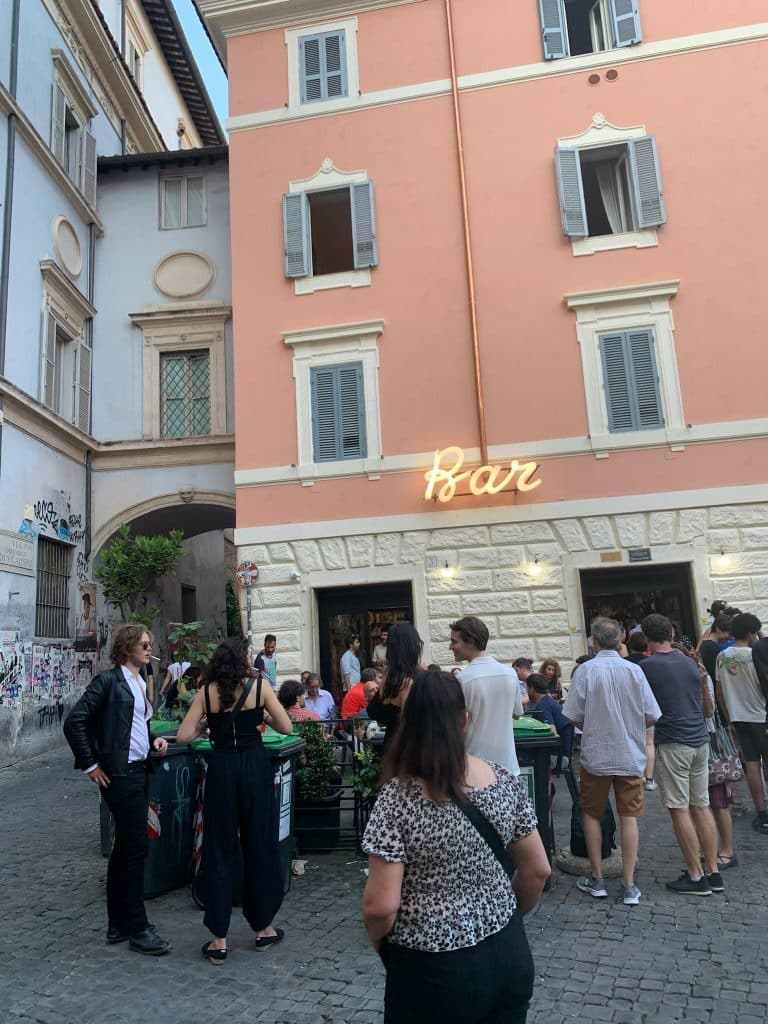
Categories of Eateries in Italy
You will stop at a variety of eateries on this tour. In Italy, eateries can be categorized from the most casual to the most formal like this:
- Bar – a bar is where you get a cappuccino or an espresso, pastries, and gelato during the day. They also serve alcohol later in the day.
- Norcineria or Salumeria – deli, pork butchery, sandwiches, beer
- Rosticceria – take out pasta, pizza, and prepared meat dishes
- Pizzeria – pizza and beer
- Osteria – traditionally this was a wine bar with some things to eat but no set menu.
- Trattoria – family owned, rustic neighborhood restaurants serving fresh, local food
- Ristorante – full service restaurant, most formal and expensive
There are also gelaterias, birrerias, and vinerias. For breads and pastries, you can find biscottificio, panetteria, and pasticceria. Just add “eria” to a word and you will have created a new place name.

Stop 1: Da Enzo al 29
We stopped at Da Enzo for a Roman appetizer on our first stop. When you put “da” in front of a name, it’s the same as saying at someone’s house or place. So Da Enzo = at Enzo’s.
Da Enzo is a highly coveted trattoria where people will stand in line for hours to get a table. Going on this food tour ensures you get to sample something from Da Enzo.
There is no printed menu at Da Enzo. Instead the daily menu is written in chalk everyday based on what fresh, local ingredients are available.
We sat down at tables in the street outside this tiny restaurant. Soon the chef brought out the sweetest melon I’ve ever tasted paired with prosciutto and fresh burrata. The burrata was so fresh having been made just a few hours earlier.
To drink we had cold water and Prosecco, a sparkling wine from the northeast of Italy.
Category: Trattoria
Location: 29 Via dei Vascellari
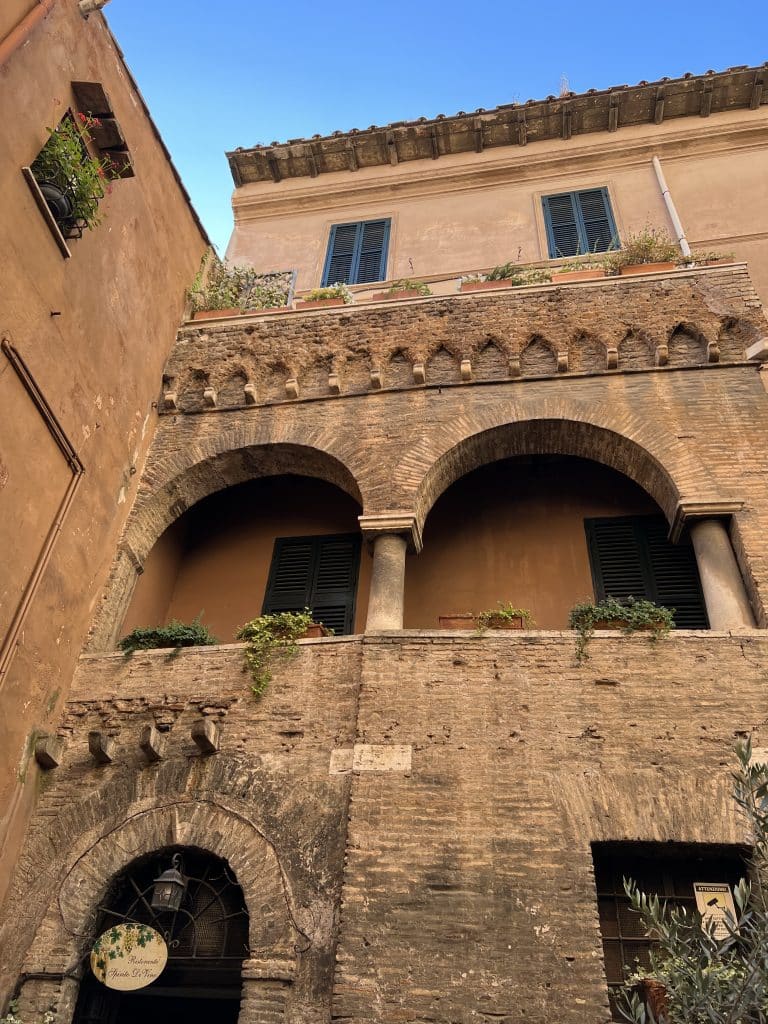
Stop 2: Spirito di Vino
Next we went to ristorante Spirito di Vino. Our guide explained that the name of this restaurant is a play on words. When spoken, it sounds like Spirito Divino (Divine Spirit) or Spirito di Vino (Spirit of Wine).
And since the restaurant is housed in a building that used to be the first Jewish synagogue in Rome and later a convent, divine spirit makes sense.
Rome is a city that keeps building on top of itself. Going down is literally going back in time. This restaurant is an example of that. Below the former synagogue are steps leading down to a wine cellar. The original floor of the wine cellar is 2,000 years old.
During excavation, archaeologists found a Roman marble copy of the original Greek bronze Statue of the Athlete. The statue is on display in the restaurant.
After the history tour, we were led outside to tables under awnings in a quiet alley behind the restaurant.
We were served an ancient pork stew made from 17 ingredients, but no salt, flavored instead by a fermented fish sauce called garum and bread to dip into the stew. To drink we had cold water and SanGiovese wine.
Category: Ristorante
Location: Via dei Genovesi 31A

Stop 3: Biscottificio Artigiano Innocenti
The first thing we noticed when walking into this family cookie factory was the amazing smell. Our mouths watering, we eagerly lined up to receive 2-3 cookies each.
My favorite were the chocolate cookies. But some people swear the brutti ma buoni (ugly but good) are the best.
The word for cookie in Italian is biscotti. It comes from Latin and means cooked twice. Cookies were baked twice in ancient times to make them hard and dry so that they last longer.
Biscotti is the Italian word for all cookies and not just the long skinny hard ones that we call biscotti.
Category: Biscottificio
Location: Via della Luce, 21
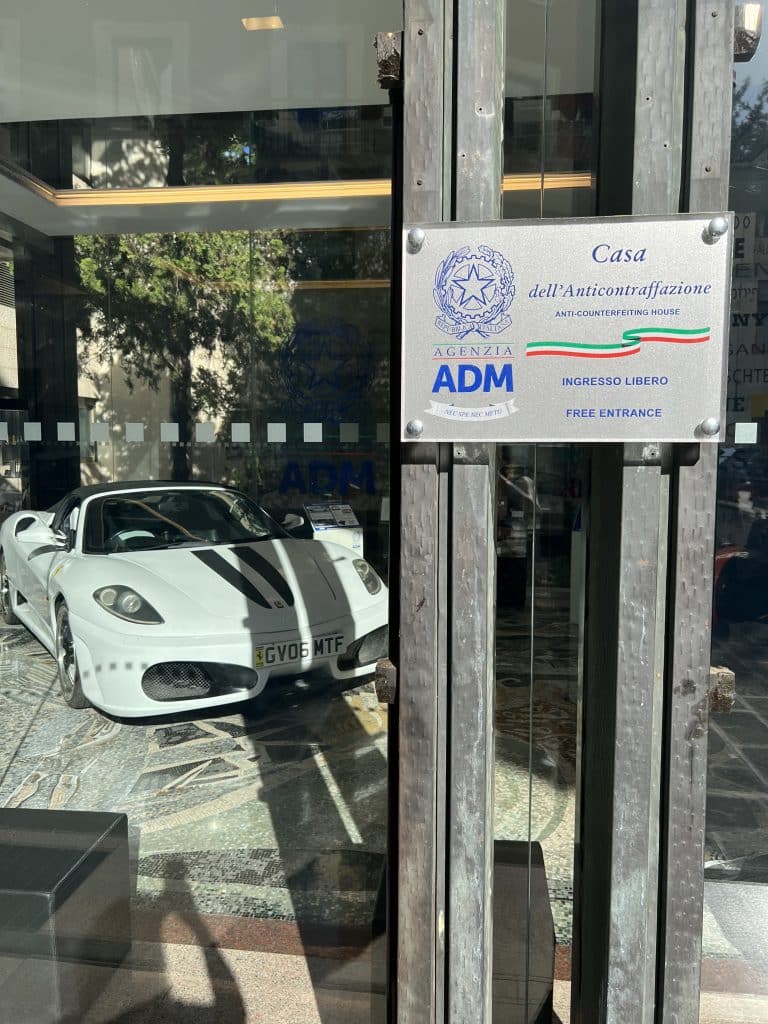
Point of Interest: Casa dell’Anticontraffazione
After hanging out in the street eating cookies, we continued our walk. Along the way our guide pointed out a few points of interest.
The first one was the Casa dell’Anticontraffazione. This is a museum of counterfeit items run by the ADM (customs agency). In the show room there was a counterfeit Ferrari.
The museum was created to show the public how much counterfeit stuff there is in Italy. The goal is to protect the Made in Italy brand.
Category: Museum
Location: Via della Luce, 34B
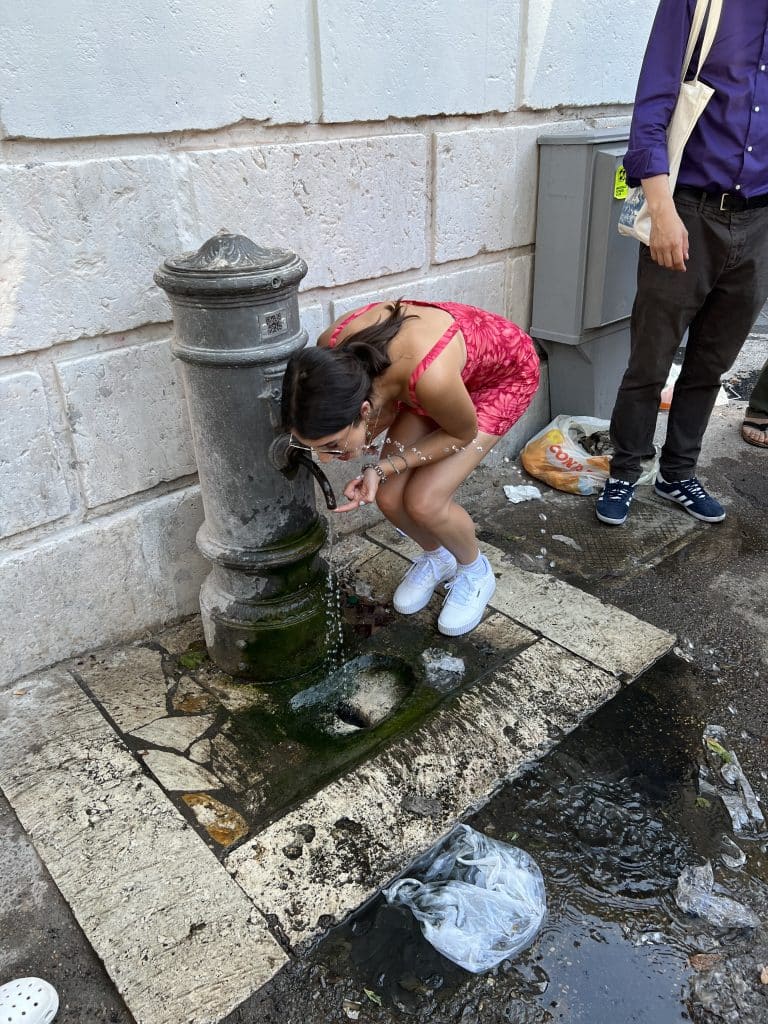
Point of Interest: Nasone
Next we passed one of the 2,500 nasoni or street drinking fountains in Rome. These cylindrical water fountains are called nasoni (plural of nasone) because the curved shape of their spouts looks like a big nose.
The water is supplied by the underground conduits created by the Romans over 2,000 years ago. The water is kept running to keep it from stagnating in the pipes and is always fresh and cold. Yes, you can drink the tap water in Rome!
Our guide showed us how to plug the spout of the big nose with our finger so that the water shoots out a hole on the top of the nose and you can drink from it. The water that goes down below is perfect for dogs.
Drinking from the nasoni or filling up your water bottle from these fountains is so much better for the environment than buying water in plastic bottles. Unfortunately, near this nasone, there were several plastic bags lying in the muddy water on the ground.
Category: Public drinking fountain
Location: Via Cardinale Merry del Val

Stop 4: La Norcineria di Iacozzilli
After quenching our thirst with fresh water from the nasone, it was time for some porchetta e pane from the Norcineria di Iacozzilli.
After learning about all the different cured meats sold at this deli, we were led to circular table tops placed on wine barrels in the street. The owner brought out slabs of crusty bread topped with tender, juicy spit roasted porchetta with herbs.
Yum! This was so tasty! We made a mental note to return here later in the week to order sandwiches for a picnic lunch.
This is also where we also had our first taste of Ichnusa beer. The owner brought out little glasses of this delicious Sardinian beer. A perfect pairing with the porchetta e pane.
Category: Norcineria
Location: Via Natale del Grande 15
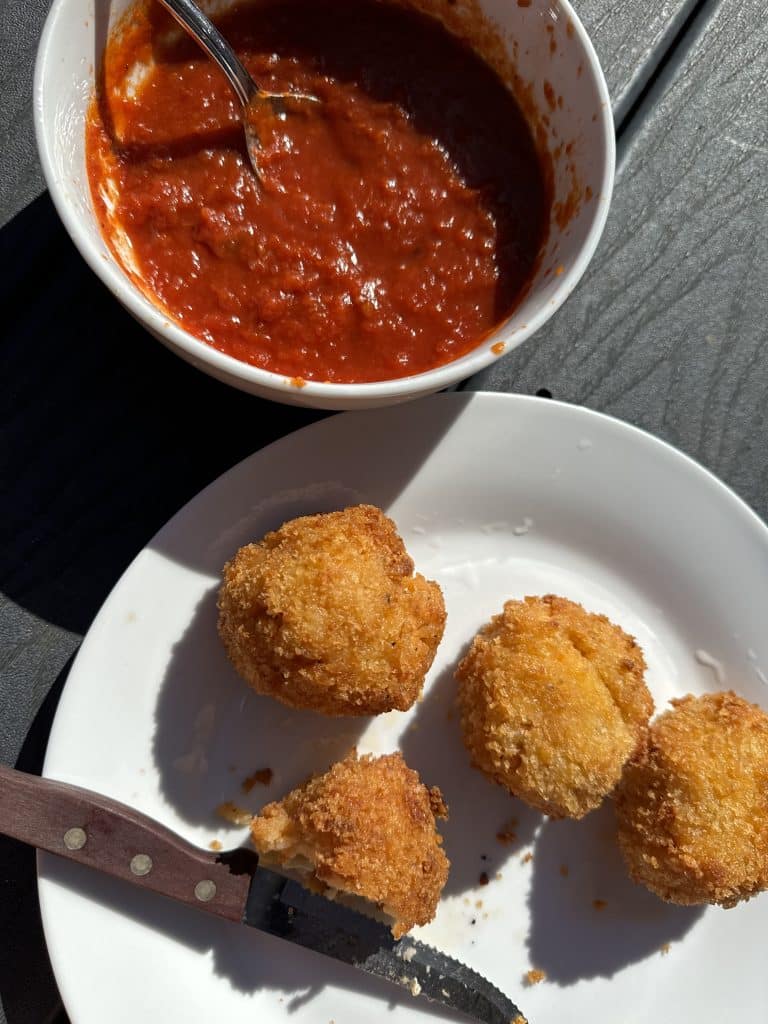
Stop 5: Supplì Roma
Next we backtracked a little to go find the hole-in-the-wall shop for Rome’s famous street food, supplì. Supplì are fried balls of risotto, mozzarella, and tomato sauce.
Our guide went into this tiny shop to get the supplì while we waited for him on the street. At first we mistakenly called these rice balls arancini until we learned that arancini is the name for a similar street food in Sicily and supplì is the name for it in Rome.
The main difference between supplì and arancini is in the sauce. The Sicilian version has meat and peas in the sauce, while the Roman supplì is made with a simple tomato sauce and lots of stringy mozzarella.
The supplì were hot and delicious. We ate them standing up in the street. Besides supplì, this shop also sells pizza by the slice and pasta dishes to go.
Category: Rosticceria
Location: Via di S. Francesco a Ripa, 137
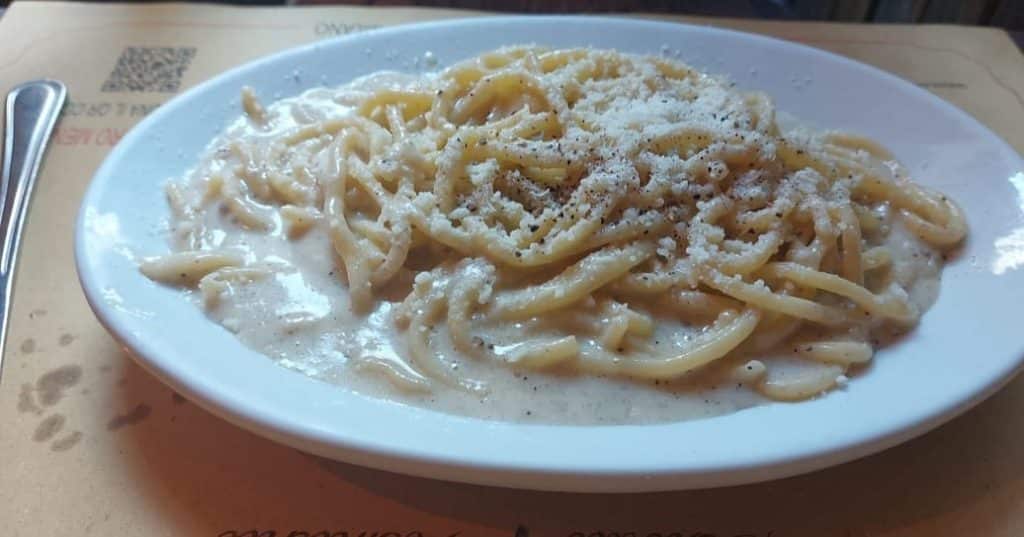
Stop 6: Trattoria Casa Mia
After all those appetizers and snacks, it was time for our final sit down meal. Sitting down and being served a meal at Trattoria Casa Mia was a welcome relief after so much walking and standing while eating.
Our entire group sat together at tables all pushed together outside on the street under awnings. A border of potted plants added greenery and protected us from the Vespas whizzing by.
The servers brought steaming bowls of traditional Roman pasta dishes to our table to share including bucatini all’amatriciana, carbonara, and cacio e pepe. My favorite was the amatriciana.
Bottles of red Chianti and a white wine were placed within reaching distance throughout the tables along with carafes of cold water. The conversation flowed and we were sad when it was time to move on.
Category: Trattoria
Location: Via della Renella, 88

Point of Interest: Basilica of Santa Maria in Trastevere
Stuffed with pasta and wine, we set off again for our final dessert destination. But along the way we passed through the Piazza di Santa Maria in Trastevere and took photos of the facade and square bell tower.
This church is famous for being the first place of Christian worship in ancient Rome. Inside you can see ornate mosaics dating back to the 12th century. It is definitely one of the most breathtaking churches in Rome.
Category: Church
Location: Piazza Santa Maria in Trastevere
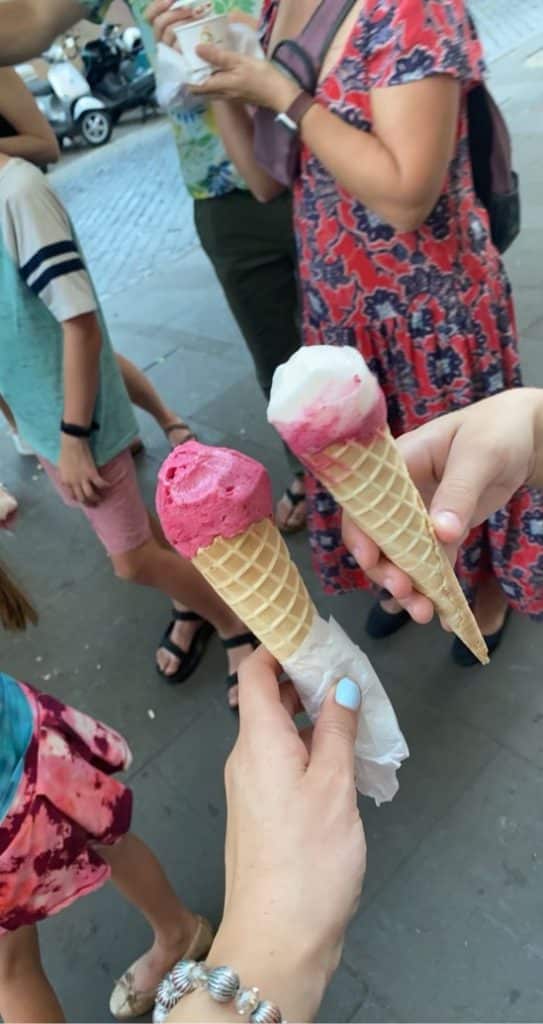
Stop 7: Gelateria Fatamorgana
Our Rome food tour in Trastevere ended with of course gelato! Our guide took us to the Gelateria Fatamorgana because it is known for serving quality gelato with unique flavors.
There are several Fatamorgana gelaterias throughout Rome near iconic sites and even a franchise in Beverly Hills.
As we gazed at the exotic flavors of gelato in the metal tubs, we received a mini lesson on how to spot authentic, quality gelato.
We learned that the vibrant colored gelato that is whipped up into creamy swirls is actually to be avoided. This is the kind of gelato that lures in the tourists but in reality fans underneath are blowing air into it to keep it fluffy and they use unnatural flavors to get those intense colors.
My favorite gelato flavor is gianduia, but I decided to try something more unique this time. I chose the melograno (pomegranate) in un cono. It was refreshing but I’m going back to gianduia (chocolate hazelnut) next time.
Category: Gelateria
Location: Via Roma Libera, 11
FAQs
Who runs the Twilight Trastevere Food Tour?
The Twilight Trastevere Food Tour is run by Eating Europe (formerly called Eating Italy). You can book the tour directly through Eating Europe or through Tripadvisor, Viator, and GetYourGuide.
How long does the Twilight Trastevere Food Tour last?
The Twilight Trastevere Food Tour lasts 4 hours. You can take the tour in the morning, afternoon, or evening.
Does every Twilight Trastevere Food Tour make the same stops?
The Twilight Trastevere Food Tour makes most of the same stops on every tour, but they do have a few different routes. You might have dessert at a restaurant on one tour but have an appetizer at the same place on a different tour. They also alternate some of the places for the sit down meals.
What should you bring on the Twilight Trastevere Food Tour?
- Comfortable shoes (you will be walking a lot)
- Water bottle (you can refill it at the public drinking fountains)
- A hat (the sun is intense in the summer)
- A camera or phone to take pictures
- Your passport (you are required to carry your passport at all times in Italy)
Trastevere for Foodies
Was this the best food tour I have ever gone on? Yes, Trastevere is for foodies! Walking and eating through the maze of meandering streets learning about the local culture in Trastevere was a perfect introduction to Rome.
Along the way, I made notes of artisan shops I wanted to return to in this unconventional neighborhood and places where I wanted to try another scrumptious dish.
We took the tour that departed at 4:15. This was perfect for all kinds of travelers, especially families. Going later in the evening would be better for couples and people traveling without children.
Make sure to come hungry because you truly eat a lot of delicious food on this tour. If you are wondering if maybe you should just do a self-guided food tour, read 13 Reasons Food Tours are Worth it in Italy.
If you want to book this tour, click here.
